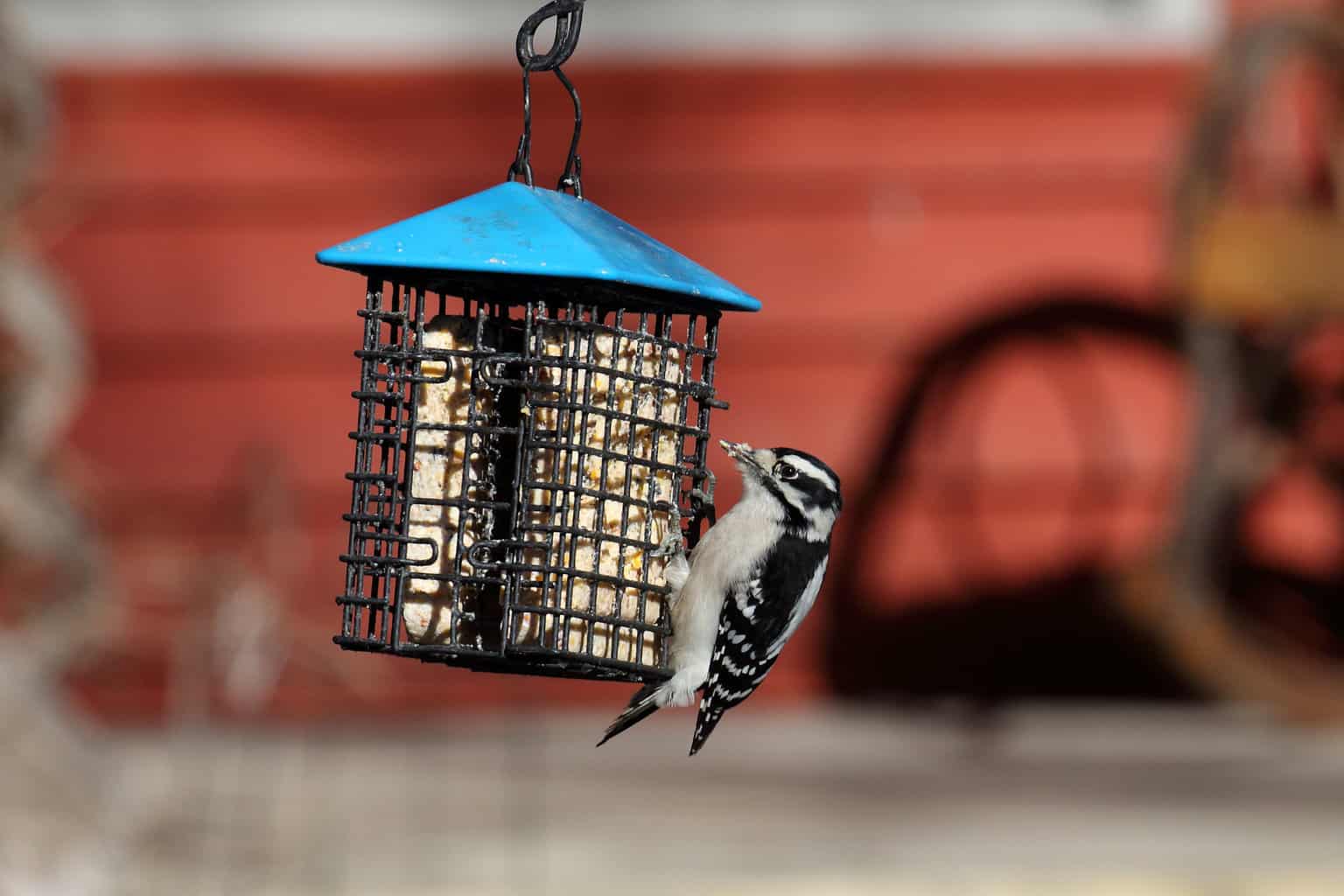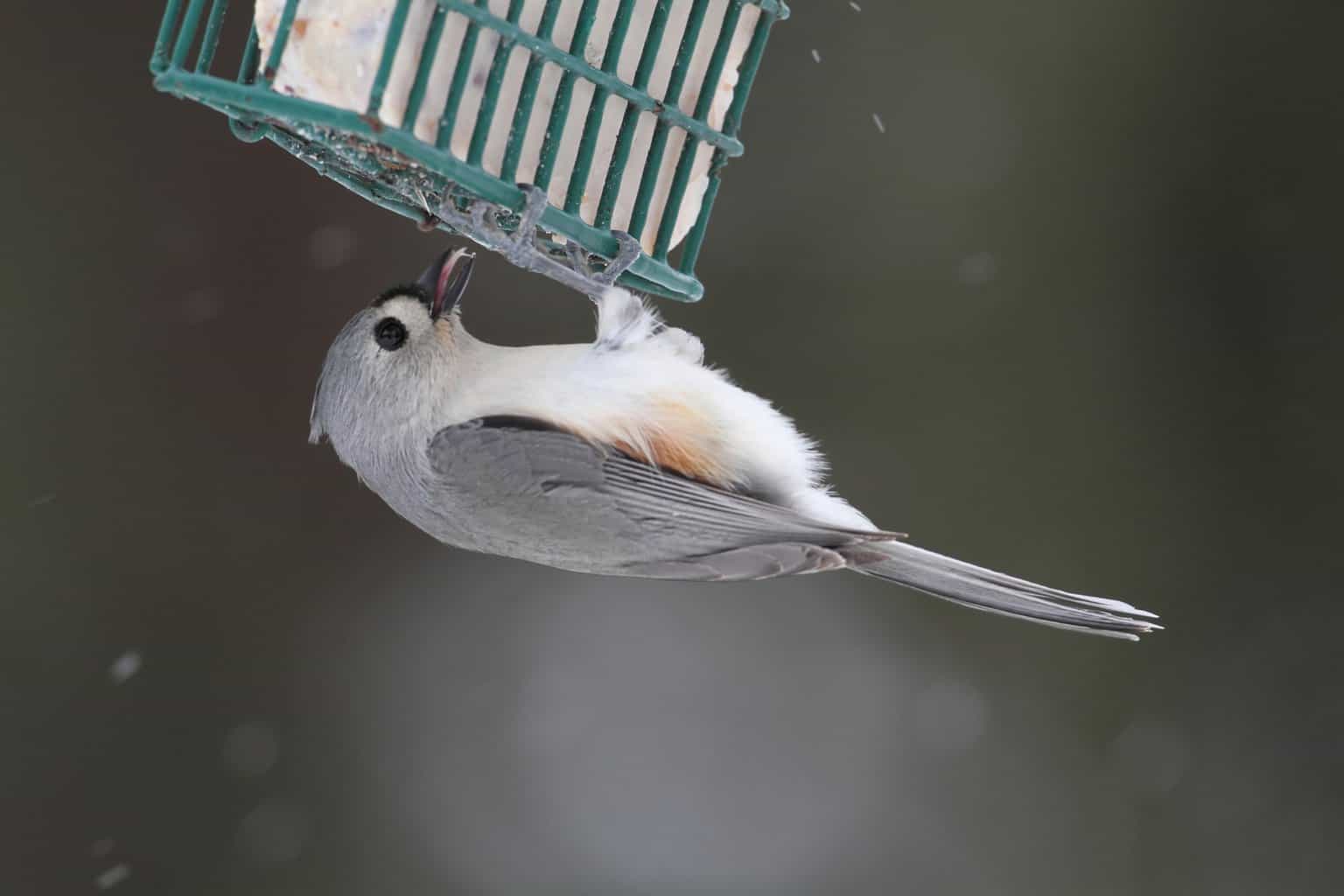A suet feeder can keep birds such as woodpeckers, nuthatches, and chickadees coming back time and time again.
Suet is a natural food source and a high-energy meal for wild birds during the cold winter months. It’s made from hard animal fat that surrounds the kidneys of animals like cows and sheep.
It is sometimes used by humans for cooking, but it’s most commonly thought of as a high-energy food for wild birds.
If you’re not familiar with suet, you can read more about this high-value bird food by clicking here.
Buying pre-made suet cakes intended for birds from a store is preferred by many people, and understandably so.
They’re pre-packaged, made to withstand melting, and often sold for between $1 and $2 per cake, even when purchased individually.
However, if you’re still wondering how to make homemade suet for birds yourself, here’s where to start.
Be Creative With Homemade Bird Suet Recipes

I got the following ideas for how to make bird suet from BB’s Blog, with some of my own additions and omissions. I hope you and the birds enjoy these recipes for bird suet!
BB mentioned that she received a request for her homemade suet recipe. Like myself, she does not follow any particular recipe.
She searched the internet for ideas and proportions, but she was also trying to avoid having to go to the store to make a purchase, so she used simple ingredients that she had on hand.
BB said it was a little sticky but that the birds loved it anyway.
6 DIY Bird Suet Recipes That Are Beak-Smack’n Good!
BB’s “Toss-It-In” Bird Suet Method
She didn’t measure anything, but these are the proportions she remembers:
Ingredients:
- 2 cups lard
- 2 cups peanut butter (smooth or crunchy)
- 2 cups oatmeal (quick or long cooking)
- 2 cups mixed birdseed (no milo or whole wheat kernels, songbirds don’t like those)
- 1 cup flour (I recommend whole wheat flour.)
Preparation:
- Place all ingredients in a large bowl.
- Mix it together well.
- Fill a re-purposed container from your home with the suet mixture, then continue to step 7.
OR
Make suet balls by the following method:
- Divide the mixture into equal portions.
- Cut string or yarn into 12-inch or 31-centimeter lengths & fold in half.
- Form each portion into a ball around half the length of the string or yarn that has been folded in half. This should leave a three-inch or eight-centimeter loop sticking out of the suet ball for hanging.
- Place the suet balls on a cookie sheet or the re-purposed container from step 3 into the refrigerator for two to three hours to firm up the suet.
- Hang outside where you will be able to enjoy watching the birds dining on their treats!
Birder’s Delight
Ingredients:
- 1 pound plain suet cut into small pieces
- 1 cup yellow cornmeal
- 1 cup rolled oats
- 1 cup crunchy peanut butter
- 1 cup mixed wild birdseed
- 1 cup hulled sunflower seed or chopped pecans
Preparation:
- Melt suet on low.
- Stir in all the other ingredients.
- When cool, pour or pack into molds, feeders, or any household item.
- Refrigerate until hardened, or freeze.
Suet Feeders ~ My Top Picks
Feathered Friends
Ingredients
- 1 cup chunky peanut butter
- 2 cups cornmeal
- 2 cups quick-cook oats
- 1 cup lard or suet
- 1 cup white flour (Again, I recommend whole wheat or whole grain.)
Preparation:
- Melt lard/suet and peanut butter together and stir.
- Stir in the remaining ingredients.
- Pour the mixture into a square container about 1-1/2 inches thick.
- Allow it to cool, then cut it into squares and store it in the freezer.
It Must Be Love
Ingredients:
- 1/2 pound fresh suet
- 1/3 cup black oil sunflower seed
- 2/3 Cup mixed wild birdseed
- 1/8 cup chopped peanuts or chopped pecans
- 1/4 cup raisins
Preparation:
- Follow the instructions for rendering suet here.
- While the suet is cooling, stir the rest of the ingredients together in a large bowl.
- Place the suet into the mixture and blend thoroughly.
- Pour or pack into molds, feeders, or any household item.
- Refrigerate until hardened, or freeze.
Peanut Butter Sandwich
Ingredients:
- 1 cup fresh suet
- 1 cup peanut butter
- 3 cups yellow cornmeal
- 1/2 cup whole wheat flour
Preparation:
- Follow the instructions for rendering suet here.
- Over low heat, melt suet and add peanut butter. Stir until well-blended.
- Mix ingredients together in a large bowl.
- Pour suet into the mixture and blend thoroughly.
- Pour or pack into molds, feeders, or any household item.
- Refrigerate until hardened, or freeze.
Captain Crunch!
Ingredients:
- 2 pounds fresh ground suet
- 1/2 cup chunky peanut butter
- 1/2 cup shelled sunflower seeds or chopped pecans
Preparation:
- Melt suet in a saucepan over low heat.
- Add peanut butter, stirring until melted and well blended.
- Stir in the sunflower seeds. Mix thoroughly.
- Pour or pack into molds, feeders, or any household item.
- Refrigerate until hardened, or freeze.

Frequently Asked Questions
Why Aren’t Birds Eating My Suet?
If you’ve just started putting out homemade suet cakes for the birds, it may take some time for them to find your feeder and realize it contains high-energy suet.
Put your feeder in an open location where birds can see it, starting your feeder close to others that birds are known to visit. Once they realize it’s there, you can start moving it a bit further away if you want.
It’s vitally important to make sure your suet stays fresh, especially during warm summer months. Suet can go bad quickly in the heat, causing a sloppy mess that’s potentially harmful to birds.
Also, consider the species of birds you’re feeding. Certain birds are known to love suet, such as woodpeckers, while others won’t seem to care for it.
Do some research about what the birds you see in your backyard like to eat to provide them with the best food options available.
What Flavor of Suet Is Birds’ Favorite?
There’s no one-size-fits-all approach to bird feeding, as tastes can vary amongst different species.
The general answer is that backyard birds prefer fresh suet that contains high-nutrient seeds, mealworms, nuts, or fruits.
Which Birds Eat Suet?
Many bird species enjoy suet, including woodpeckers, nuthatches, chickadees, and more. It’s a high-energy food source that can be essential for their survival during the winter months.
When Should Suet Be Put Outdoors?
Suet can be put outdoors at any time, but it’s particularly useful during the winter months when birds need extra calories to stay warm. However, it’s crucial to ensure it doesn’t spoil in hot weather or attract unwanted pests.
Does Suet Go Bad?
Yes, suet can go bad, especially in warmer weather. It’s essential to check the suet regularly for signs of spoilage and replace it as necessary to ensure the health and safety of your backyard birds.

